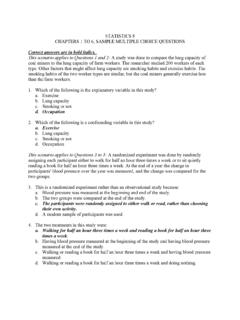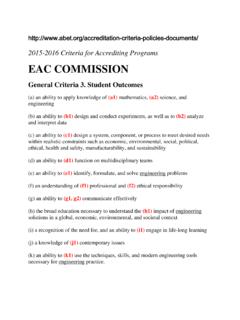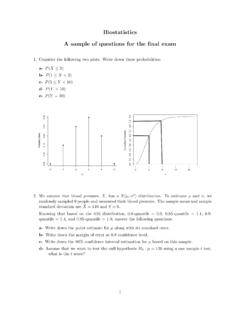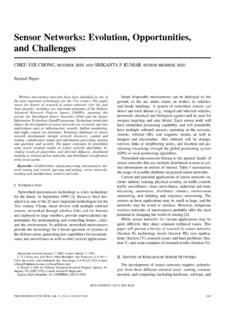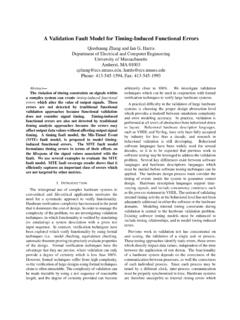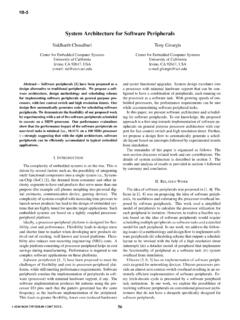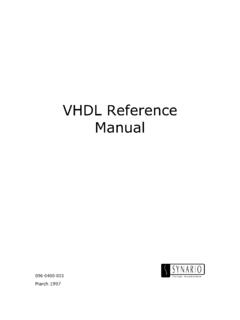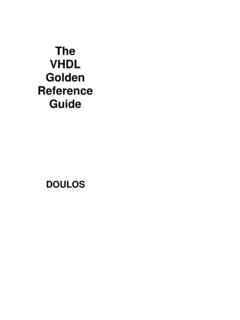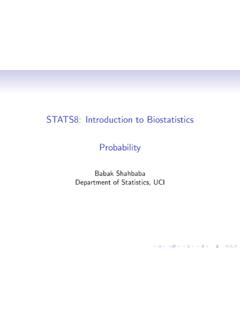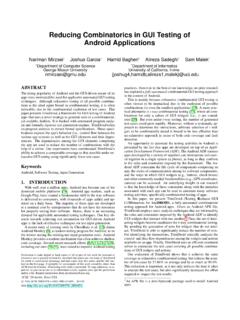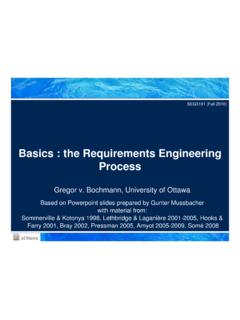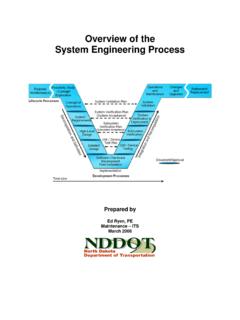Transcription of Process Models in Software Engineering
1 Process Models in Software Engineering Walt Scacchi, Institute for Software Research, University of California, Irvine February 2001. Revised Version, May 2001, October 2001. Final Version to appear in, Marciniak (ed.), Encyclopedia of Software Engineering , 2nd Edition, John Wiley and Sons, Inc, New York, December 2001. Introduction Software systems come and go through a series of passages that account for their inception, initial development, productive operation, upkeep, and retirement from one generation to another. This article categorizes and examines a number of methods for describing or modeling how Software systems are developed. It begins with background and definitions of traditional Software life cycle Models that dominate most textbook discussions and current Software development practices. This is followed by a more comprehensive review of the alternative Models of Software evolution that are of current use as the basis for organizing Software Engineering projects and technologies.
2 Background Explicit Models of Software evolution date back to the earliest projects developing large Software systems in the 1950's and 1960's (Hosier 1961, Royce 1970). Overall, the apparent purpose of these early Software life cycle Models was to provide a conceptual scheme for rationally managing the development of Software systems. Such a scheme could therefore serve as a basis for planning, organizing, staffing, coordinating, budgeting, and directing Software development activities. Since the 1960's, many descriptions of the classic Software life cycle have appeared ( , Hosier 1961, Royce 1970, Boehm 1976, Distaso 1980, Scacchi 1984, Somerville 1999). Royce (1970). originated the formulation of the Software life cycle using the now familiar "waterfall" chart, displayed in Figure 1. The chart summarizes in a single display how developing large Software systems is difficult because it involves complex Engineering tasks that may require iteration and rework before completion.
3 These charts are often employed during introductory presentations, for people ( , customers of custom Software ) who may be unfamiliar with the various technical problems and strategies that must be addressed when constructing large Software systems (Royce 1970). These classic Software life cycle Models usually include some version or subset of the following activities: System Initiation/Planning: where do systems come from? In most situations, new 1. feasible systems replace or supplement existing information processing mechanisms whether they were previously automated, manual, or informal. Requirement Analysis and Specification: identifies the problems a new Software system is suppose to solve, its operational capabilities, its desired performance characteristics, and the resource infrastructure needed to support system operation and maintenance. Functional Specification or Prototyping: identifies and potentially formalizes the objects of computation, their attributes and relationships, the operations that transform these objects, the constraints that restrict system behavior, and so forth.
4 Partition and Selection (Build vs. Buy vs. Reuse): given requirements and functional specifications, divide the system into manageable pieces that denote logical subsystems, then determine whether new, existing, or reusable Software systems correspond to the needed pieces. Architectural Design and Configuration Specification: defines the interconnection and resource interfaces between system subsystems, components, and modules in ways suitable for their detailed design and overall configuration management. Detailed Component Design Specification: defines the procedural methods through which the data resources within the modules of a component are transformed from required inputs into provided outputs. Component Implementation and Debugging: codifies the preceding specifications into operational source code implementations and validates their basic operation. Software Integration and Testing: affirms and sustains the overall integrity of the Software system architectural configuration through verifying the consistency and completeness of implemented modules, verifying the resource interfaces and interconnections against their specifications, and validating the performance of the system and subsystems against their requirements.
5 Documentation Revision and System Delivery: packaging and rationalizing recorded system development descriptions into systematic documents and user guides, all in a form suitable for dissemination and system support. Deployment and Installation: providing directions for installing the delivered Software into the local computing environment, configuring operating systems parameters and user access privileges, and running diagnostic test cases to assure the viability of basic system operation. Training and Use: providing system users with instructional aids and guidance for understanding the system's capabilities and limits in order to effectively use the system. Software Maintenance: sustaining the useful operation of a system in its host/target environment by providing requested functional enhancements, repairs, performance 2. improvements, and conversions. What is a Software life cycle model ? A Software life cycle model is either a descriptive or prescriptive characterization of how Software is or should be developed.
6 A descriptive model describes the history of how a particular Software system was developed. Descriptive Models may be used as the basis for understanding and improving Software development processes, or for building empirically grounded prescriptive Models (Curtis, Krasner, Iscoe, 1988). A prescriptive model prescribes how a new Software system should be developed. Prescriptive Models are used as guidelines or frameworks to organize and structure how Software development activities should be performed, and in what order. Typically, it is easier and more common to articulate a prescriptive life cycle model for how Software systems should be developed. This is possible since most such Models are intuitive or well reasoned. This means that many idiosyncratic details that describe how a Software systems is built in practice can be ignored, generalized, or deferred for later consideration. This, of course, should raise concern for the relative validity and robustness of such life cycle Models when developing different kinds of application systems, in different kinds of development settings, using different programming languages, with differentially skilled staff, etc.
7 However, prescriptive Models are also used to package the development tasks and techniques for using a given set of Software Engineering tools or environment during a development project. Descriptive life cycle Models , on the other hand, characterize how particular Software systems are actually developed in specific settings. As such, they are less common and more difficult to articulate for an obvious reason: one must observe or collect data throughout the life cycle of a Software system, a period of elapsed time often measured in years. Also, descriptive Models are specific to the systems observed and only generalizable through systematic comparative analysis. Therefore, this suggests the prescriptive Software life cycle Models will dominate attention until a sufficient base of observational data is available to articulate empirically grounded descriptive life cycle Models . These two characterizations suggest that there are a variety of purposes for articulating Software life cycle Models .
8 These characterizations serve as a Guideline to organize, plan, staff, budget, schedule and manage Software project work over organizational time, space, and computing environments. Prescriptive outline for what documents to produce for delivery to client. Basis for determining what Software Engineering tools and methodologies will be most appropriate to support different life cycle activities. Framework for analyzing or estimating patterns of resource allocation and consumption during the Software life cycle (Boehm 1981). Basis for conducting empirical studies to determine what affects Software productivity, cost, and overall quality. 3. What is a Software Process model ? In contrast to Software life cycle Models , Software Process Models often represent a networked sequence of activities, objects, transformations, and events that embody strategies for accomplishing Software evolution. Such Models can be used to develop more precise and formalized descriptions of Software life cycle activities.
9 Their power emerges from their utilization of a sufficiently rich notation, syntax, or semantics, often suitable for computational processing. Software Process networks can be viewed as representing multiple interconnected task chains (Kling 1982, Garg 1989). Task chains represent a non-linear sequence of actions that structure and transform available computational objects (resources) into intermediate or finished products. Non-linearity implies that the sequence of actions may be non-deterministic, iterative, accommodate multiple/parallel alternatives, as well as partially ordered to account for incremental progress. Task actions in turn can be viewed a non-linear sequences of primitive actions which denote atomic units of computing work, such as a user's selection of a command or menu entry using a mouse or keyboard. Winograd and others have referred to these units of cooperative work between people and computers as "structured discourses of work" (Winograd 1986), while task chains have become popularized under the name of "workflow" (Bolcer 1998).
10 Task chains can be employed to characterize either prescriptive or descriptive action sequences. Prescriptive task chains are idealized plans of what actions should be accomplished, and in what order. For example, a task chain for the activity of object-oriented Software design might include the following task actions: Develop an informal narrative specification of the system. Identify the objects and their attributes. Identify the operations on the objects. Identify the interfaces between objects, attributes, or operations. Implement the operations. Clearly, this sequence of actions could entail multiple iterations and non-procedural primitive action invocations in the course of incrementally progressing toward an object-oriented Software design. Task chains join or split into other task chains resulting in an overall production network or web (Kling 1982). The production web represents the "organizational production system" that transforms raw computational, cognitive, and other organizational resources into assembled, integrated and usable Software systems.
